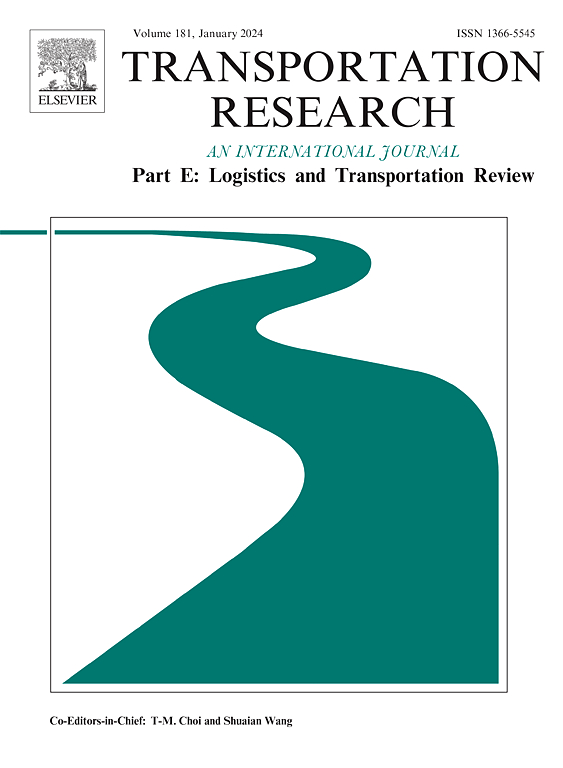破坏不确定条件下的先发制人设施拦截
IF 8.3
1区 工程技术
Q1 ECONOMICS
Transportation Research Part E-Logistics and Transportation Review
Pub Date : 2025-03-26
DOI:10.1016/j.tre.2025.104081
引用次数: 0
摘要
先发制人的设施拦截问题旨在通过主动瞄准对手的关键设施来禁用或减少未来来自对手的威胁。本研究推广了有能力设施的先发制人设施拦截问题。该问题被表述为一个双层优化问题,其中上层拦截者决定攻击多个设施,以最大化下层对手(防御者)部队的供应成本。我们做了一个现实的假设,即攻击决策后的损害程度是不确定的,导致防御者提供一些需求点的部分可用能力。网络保卫者可能允许需求短缺,同时可以选择以固定成本和可能更高的运输成本将一些需求重新分配到其他设施。防御者对攻击做出反应,以最小的预期成本保持供应网络的运行。这个问题是np困难的,需要大量的计算才能解决,特别是在大规模的情况下。我们设计了一个切割平面,包含(1)最优切割,以指导我们获得最优解;(2)基于主导解设计的所谓的-k切割,以提高效率。我们对我们的设施拦截问题进行了广泛的实验,通过灵敏度分析来解决问题的实际方面,并通过解决具有较小最优性差距的相对较大的实例来解决解决方法的计算方面。此外,我们还对这种拦截问题如何影响决策过程提出了一些实际见解。本文章由计算机程序翻译,如有差异,请以英文原文为准。
Preemptive facility interdiction under damage uncertainty
The preemptive facility interdiction problem aims to disable or diminish future threats from adversaries by proactively targeting their critical facilities. This research generalizes a preemptive facility interdiction problem with capacitated facilities. The problem is formulated as a bi-level optimization problem in which the interdictor, at the upper level, decides to attack several facilities to maximize the supply cost of the adversary (defender) force at the lower level. We make a realistic assumption that the magnitude of damage after the attack decisions is uncertain, leading to the partially available capacity for the defender to supply some of the demand points. The network defender may allow for a demand shortage while having the option to reallocate some of the demands to alternative facilities at a fixed cost and potentially higher transportation costs. The defender reacts to the attack to keep the supply network operational at the minimum expected cost.
This problem is NP-hard and computationally intensive to solve, particularly on a large scale. We have designed a cutting plane incorporating (1) optimality cuts to guide us towards an optimal solution and (2) so-called minus-k cuts devised based on the dominant solutions to improve efficiency. We have conducted extensive experiments on our facility interdiction problem to address the practical aspects of the problem by sensitivity analysis and the computational aspects of the solution method by solving relatively large instances with a small optimality gap. Furthermore, we draw some practical insights into how the decision-making process is affected in such an interdiction problem.
求助全文
通过发布文献求助,成功后即可免费获取论文全文。
去求助
来源期刊
CiteScore
16.20
自引率
16.00%
发文量
285
审稿时长
62 days
期刊介绍:
Transportation Research Part E: Logistics and Transportation Review is a reputable journal that publishes high-quality articles covering a wide range of topics in the field of logistics and transportation research. The journal welcomes submissions on various subjects, including transport economics, transport infrastructure and investment appraisal, evaluation of public policies related to transportation, empirical and analytical studies of logistics management practices and performance, logistics and operations models, and logistics and supply chain management.
Part E aims to provide informative and well-researched articles that contribute to the understanding and advancement of the field. The content of the journal is complementary to other prestigious journals in transportation research, such as Transportation Research Part A: Policy and Practice, Part B: Methodological, Part C: Emerging Technologies, Part D: Transport and Environment, and Part F: Traffic Psychology and Behaviour. Together, these journals form a comprehensive and cohesive reference for current research in transportation science.

 求助内容:
求助内容: 应助结果提醒方式:
应助结果提醒方式:


